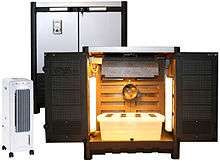Grow box
Grow boxes may be soil-based or hydroponic. The most sophisticated examples are totally enclosed, and contain a built-in grow light, intake and exhaust fan system for ventilation, hydroponics system that waters the plants with nutrient-rich solution, and an odor control filter. Some advanced grow box units even include air conditioning to keep running temperatures down, as well as CO
2 to boost the plant's growth rate. These advanced elements allow the gardener to maintain optimal temperature, light patterns, nutrition levels, and other conditions for the chosen plants.[1]

A grow box ( is a protected trademark for these categories in many countries (WIPO World Intellectual Property Organization) is a partially or completely enclosed system for raising plants indoors or in small areas. Grow boxes are used for a number of reasons, including lack of available outdoor space or the desire to grow vegetables, herbs or flowers during cold weather months. They can also help protect plants against pests or disease.
Key growlight options include fluorescent bulbs, which offer relatively limited light output; high-intensity discharge lamps such as sodium-vapor lamps and metal-halide lamps; and light-emitting diodes bulbs, which are becoming more energy-efficient.
In different sizes and degrees of complexity, grow boxes are also referred to as grow cabinets and lightproof cabinets. A full-room version of a grow box is a growroom.
Important basic parts of grow cabinet
Grow cabinets have many different pieces of equipment that improve plant growth and yields. The system will usually allow its owner to control all conditions inside the cabinet to make them perfect for growth. Below is a chart of different pieces of equipment on many commercially-built cabinets.
| Names of Equipment | Use/Benefits | Types |
|---|---|---|
| Carbon filter | - Actively filters/cleans the air and prevents smells from escaping into areas around the grow. | - Cylinder filters in different heights and diameters. |
| Lighting systems | - Allow for control of seasons, increased energy up take, etc. over sun light. | - CFL (Compact Fluorescent Light), |
| Hydroponic systems | - Growing plants in nutrient solution allows for increased nutrient uptake with better yields and growth rates over soil growing | Deep water culture, aeroponics, drip irrigation, EB & flow systems, floater systems, and wick systems |
| Ventilation | - Allows for circulation of air to control humidity and temperature conditions. | Includes:
- Induct fan, rotating fan, light hood cooling fan |
| Carbon dioxide systems | - Allow for control of CO2 levels to improve photosynthesis rates | Includes: Cans that slowly release it and are completely disposable. Tank systems that slowly release CO2 from a tank at a set rate. |
| Water filtering system | - Allow for filtering of nutrient solution to remove particles that are harmful for plants or could damage the hydroponic system. | - Many different types from inline filters to filtering systems placed in nutrient solution. |
See also
- Aeroponics
- Growbag
- Growroom
- Ultrasonic Hydroponic Fogger
- Hydroponic dosers
- Hydroponics
- Pot farming
References
- "Grow box glossary entry on MyFreshLocal.com". Archived from the original on 2012-06-29. Retrieved 2012-02-07.
External links
| Wikimedia Commons has media related to Grow box. |
- Barak, P. 2002. Essential Elements for Plant Growth: Hydroponics.
- Hershey, D.R. 1994. Solution culture hydroponics: history and inexpensive equipment. American Biology Teacher 56:111-118.
- Jensen, M.H. 1997. Hydroponics. HortScience 32
- Hydroponics as a Hobby: Growing Plants Without Soil. University of Illinois Circular 844
- Utah State University Hydroponics
- Hydroponics at McMurdo Station Antarctica
- Cornell University Commercial Hydroponic Lettuce, Spinach and Pak Choi Grower's Handbooks
- Hydroponics and Soilless Cultures on Artificial Substrates as an Alternative to Methyl Bromide Soil Fumigation